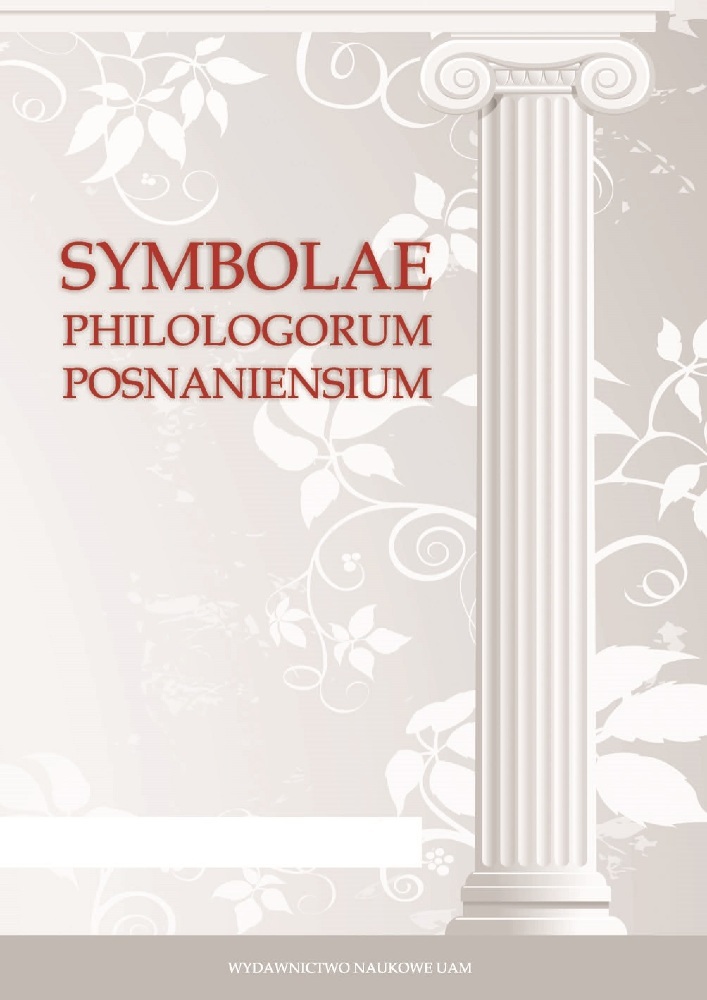Abstract
The article, focusing primarily on the Odyssey 5. 135–6, offers a set of remarks designed to foreground the qualities that make the Calypso episode not only interesting as an example of how the epic poet exploits traditional themes and phrases, but exciting as a story of a man’s desire.Literaturhinweise
Alden 1985: Alden, M. J. 1985. “The Rôle of Calypso in the Odyssey.” Antike und Abendland 31: 97–107.
Anderson 1958: Anderson, W. S. 1958. “Calypso and Elysium.” The Classical Journal 54, 2–11.
Brügger 2016: Brügger, C. 2016. Homers Ilias. Gesamtkommentar, herausgegeben von A. Bierl und J. Latacz, Band IX 2: Kommentar von C. Brügger, Berlin.
Buchan 2004: Buchan, M. 2004. The Limits of Heroism. Homer and the Ethics of Reading. Ann Arbor.
Cairns 2001: Cairns, D. L. 2001. Oxford Readings in Homer’s Iliad. Oxford.
Cavafy 1992: Cavafy, C. P. 1992. Collected Poems. Transl. by E. Keeley, Ph. Sherrard. Princeton.
Crane 1988: Crane, G. 1988. Calypso: Backgrounds and Conventions in the Odyssey. Frankfurt am Main.
Currie 2016: Currie, B. 2016. Homer’s Allusive Art. Oxford.
Danek 1998: Danek, Z. 1998. Epos und Zitat. Studien zu den Quellen der Odyssee. Wien.
Davies 1989: Davies, M. 1989. The Epic Cycle. Bristol.
De Jong 2001: de Jong, I. 2001. A Narratological commentary to the Odyssey. Cambridge.
Faulkner 2008: Faulkner, A. The Homeric Hymn to Aphrodite. Introduction, Text, and Commentary. Oxford:
Finkelberg 2015: Finkelberg, M. 2015. “Meta-Cyclic Epic and Homeric Poetry.” In The Greek Epic Cycle and Its Ancient Reception. Ed. by M. Fantuzzi and Ch. Tsagalis, 126–138. Cambridge.
Finley 1978: Finley, J. H. 1978. Homer’s Odyssey. Cambridge and London.
Giannini 2014: Giannini, P. 2014. “Il viaggio dell’avventura: Odisseo.” In Terra marique. Ricerche sul team del viaggio nella letteratura classica. Ed. by M. Capasso, 51–64. Lecce.
Garvie 1994: Garvie, A. F. Homer. Odyssey, Books VI-VIII. Cambridge.
Griffin 1977: Griffin, J. 1977. “The epic Cycle and the Uniqueness of Homer.” JHS 97: 39–53.
Güntert 1919: Güntert, H. Kalypso. 1919. Bedeutungsgeschichtliche Untersuchungen auf dem Gebiet der indogermanischen Sprachen. Halle.
Hainsworth 1988. Hainsworth, J. B. 1988. “Commentary on Books V–VIII.” In A Commentary on Homer’s Odyssey, vol. I. Ed. by A. Heubeck, S. West, and J. B. Hainsworth, 249–385.Oxford.
Heubeck 1989: Heubeck, A. “Comemntary on Books IX-XII.” In A Commentary on Homer’s Odyssey, vol. II,. Ed. by A. Heubeck, A. Hoekstra, 3–116. Oxford.
Kozłowski 2015: Kozłowski, J. 2015. “Akadyjski epos o Gilgameszu i Odyseja.” Roczniki Humanistyczne 63, 5–22.
Kullmann 2015: Kullmann, W. 2015. “Motif and Source Research: Neoanalysis, Homer and Cyclic Epic.” In The Greek Epic Cycle and Its Ancient Reception. Ed. by M. Fantuzzi, Ch. Tsagalis, 108–125. Cambridge.
Lohmann 1988: Lohmann, D. 1988. Kalypso bei Homer und J. Joyce. Tübingen.
Mackie 1995: Mackie, H. 1995. “Song and Storytelling: An Odyssean Perspective.” Poetica 5: 77–94.
Mitro 2008: Mitro, M. S. 2008. “«Mi disse: immortale / sarai, se rimani…» Calypso e Giovanni Pascoli.” Maia 60, 6–14.
Most 2007: Most, G. W. 2007. Hesiod. The Shield, Catalogue of Women, Other Fragments. Cambridge (Mass.)–London.
Murray 1998: Murray, A. T. 1998. Homer. Odyssey. Books 1–12 Homer 1998. Cambridge (Mass.)–London.
Murray 2001: Murray, A. T. 2001. Homer. Iliad. Books 13–24. Cambridge (Mass.)–London.
Murray 2004: Murray, A. T. 2004. Homer. Odyssey. Books 13–24. Cambridge (Mass.)–London.
Nagy 2010: Nagy, G. 2010. Homer the Preclassic. Berkeley–Los Angeles.
Pelling 2014: Pelling, Ch. 2014. Homer. In Twelve Voices from Greece and Rome. Ancient Ideas for Modern Times. Ed. by Ch. Pelling, M. Wyke. Oxford.
Ponatni 2013: Pontani F. 2013. “Speaking and Concealing. Calypso in the Eyes of Some (Ancient) Interpreters.” Symbolae Osloenses 87, 30–60.
Pulleyn 2006: Pulleyn, S. 2006. “Homer’s Religion: Philological Perspectives from Indo-European and Semitic.” In Epic Interactions. Perspectives on Homer, Virgil, and Epic Tradition Presentes to Jasper Griffin by Former Pupils. Ed. by M. J. Clarke, B. G . F. Currie, and R. O. A. M. Lyne, 47–74. Oxford.
Redfield 1994: Redfield, J. M. 1994. Nature and Culture in the Iliad. The Tragedy of Hector, Durham-London.
Richardson 2010. Richardson, N. 2010. Three Homeric Hymns. To Apollo, Hermes, and Aphrodite. Cambridge.
Rutherford 1991–1993. Ruttherford, R. B. 1991–1993. “From the Iliad to the Odyssey.” BICS 38: 37–54.
Sammons 2010: Sammons, B. 2010. The Art and Rhetoric of the Homeric Catalogue. Oxford.
Scodel 2009: Scodel, R. 2009. Listening to Homer: Tradition, Narrative and Audience. Michigan.
Thornton 1970: Thornton, A. 1970. People and Themes in Homer’s Odyssey. Dunedi.
Vernant 1996: Vernant, J.-P. 1996. “The Refusal of Odysseus.” In Reading the Odyssey. Selected Interpretative Essays. Ed by. S. L. Schein, 185–9. Princeton.
Walcot 1991. Walcot, P. 1991. “The Homeric Hymn to Aphrodite. A Literary Appraisal.” Greece and Rome 38: 137–155.
West 1997: West, M. L. 1997. The East Face of Helicon: West Asiatic Elements in Greek Poetry and Myth. Oxford.
West 2003: West, M. L. 2003. Homeric Hymns. Homeric Apocrypha. Lives of Homer. Cambridge (Mass.)–London.
West 2007: West, M. L. 2007. Indo-european Poetry and Myth. Oxford.
West 2013: West M. L. 2013. The Epic Cycle. A Commentary on the Lost Troy Epics. Oxford.
West 2014: West, M. L. 2014. The Making of the Odyssey. Oxford.
Wright-Mead 2011: Wright, T. and D. Mead. 2011. Oscar Wilde. The Women of Homer. London.
Zieliński 2014: Zieliński, K. 2014. Iliada i jej tradycja epicka. Studium z zakresu greckiej tradycji oralnej. Wrocław.
Lizenz
